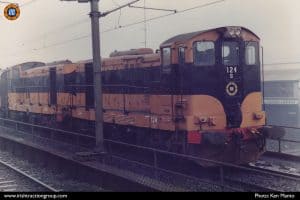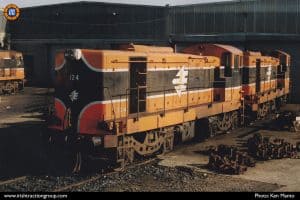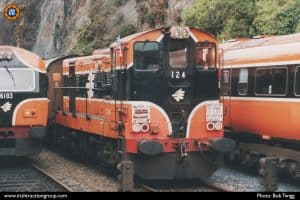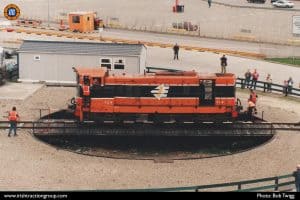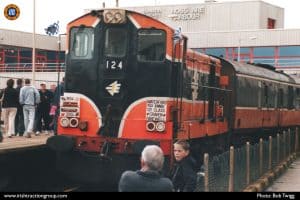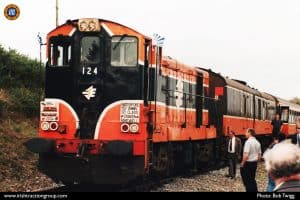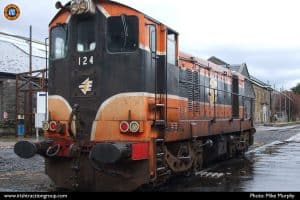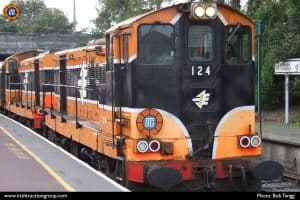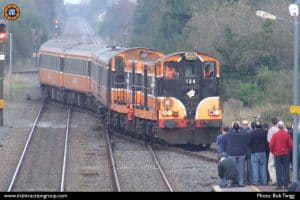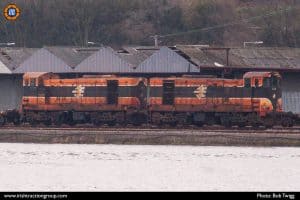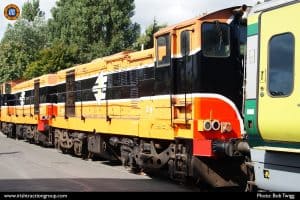Locomotive 124 was built for Coras Iompair Éireann (CIE), the Irish State owned transport company, by General Motors at their premises at La Grange, Illinois, USA in 1960. Originally numbered B124, was part of a class of 15 single cab Bo-
B124 entered traffic with CIE on 29th March 1961. The letter prefix ‘B’ was dropped from 1972 onwards, and the locomotive eventually became 124, with the fleet now known simply as the 121 class.
The 121 (B) class locomotives could be seen operating all over the Irish Rail network, hauling both passenger and freight services. However, due to problems encountered with driver visibility when running bonnet first, their sphere of operation when running singly was restricted as they had to be turned on turntables at the end of most journeys so that the cab was leading each time. In the early days this was not too much of a problem, as most terminal stations still had operational turntables left over from steam days. However, as the number of operational turntables gradually reduced over a period of time, this restricted the number of routes that the class could operate over when running singly. As such, the locomotives were then regularly marshalled in pairs, operating in multiple with their cabs outermost, or coupled in multiple with 141 (B) or 181 (B) class locomotives, again with the 121 class’ cab outermost.
In the 1970s and early 1980s, pairs of 121 class locomotives were the staple form of motive power on the Dublin Connolly to Sligo line and also the Dublin Connolly to Rosslare Harbour line. However, two notable duties did still remain for a single 121 class locomotive. Firstly, there was the early morning Dublin Heuston to Cork passenger/mail service, which returned from Cork to Dublin Heuston during the late afternoon. In the later years, this train was usually formed of just one Travelling Post Office, one Cravens passenger coach, and one Steam Generating Van. This service continued until the transport of mail by rail was discontinued in January 1994. The other passenger duty for a single locomotive was the Bray to Greystones push/pull shuttle service, which was formed of former AEC railcar vehicles built between 1951 and 1954, which were converted to push/pull hauled stock in 1972/73. The 121 class locomotives took over operating this push/pull service in 1985/86, following the withdrawal of the 201 (C) Class locomotives which had previously operated this service. The use of 121 class locomotives on this working eventually ended in September 1987 when the AEC-
The first casualty was locomotive 125, which suffered a major electrical fire on 6th March 1986, and never ran again, spending the next 16 years stored at Inchicore Works, Dublin, before it was finally scrapped in 2002.
In 1988-
The next 121 class locomotive to go was locomotive 132, which suffered an electrical fire on 19th May 1994. Locomotive 121 was the next of the class to be taken out of service, again after suffering fire damage on 29th June 1995. This was closely followed by locomotive 126 which suffered serious engine damage during July 1995.
While originally built with GM 8-567CR engines, many of the 121 class locomotives would go onto have their original engines exchanged with GM 8-
Around 2001/2002,it was decided decision to refurbish the 121 class locomotives, and things hopeful. . The refurbishment was to include an overhaul of the body and cab interior. However, a decline in freight traffic meant led to a decision to withdraw most of the class, and ultimately only 123, 124, 131 and 134 received this overhaul. Withdrawals started in mid-
However, the 121 class retained one passenger duty, that being the Limerick to Limerick Junction shuttle service, which used a Mark 3 push/pull carriage set. 124 and 134 would take turns on this service until 9th March 2004, when the Limerick Junction shuttle was taken over by 2700 class railcar sets.
After the being ousted from the Limerick Junction shuttle, locomotives 124 and 134 continued to fly the flag for the 121 class, often (but not exclusively) running together as a pair. Duties included freight and permanent way trains, with the locos also being popular on railtours during this period. 124 and 134 were finally withdrawn on 31st March 2008, thus ending the career of the 121 class locomotives on Irish Railways after four and a half decades.
Following their eventual withdrawal, both locomotives were then stored at Inchicore Works awaiting preservation. Locomotive 124 was secured for preservation by the Irish Traction Group on 7th November 2009, and was sold to the Group for the nominal sum of €1 plus VAT.
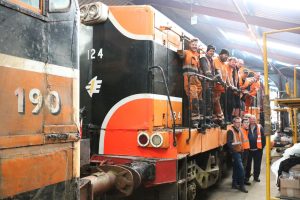
Volunteers and supporters pose with our preserved 121 class loco, 124, on its arrival in DCDR's workshop.
124 was moved by low-
124 was successfully started for the first time in preservation on Saturday 14th June 2025, marking the start of restoration to running order.
After two months of frantic efforts, 124 surprised many attendees at the 23rd August 2025 diesel gala in Downpatrick by not only appearing on a photography run-past, but also hauling the final passenger train of the day, marking the first workings of a preserved 121 class in Ireland.
Further overhaul, both mechanical and bodywork, remains to be completed, but this was a major milestone in the preservation story of Irish diesel locomotives.
